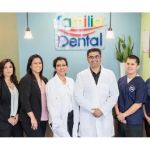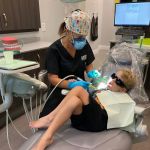Signs of Oral Yeast Infection: What You Need to Know
- 1. Understanding Oral Yeast Infections
- 2. Common Signs and Symptoms of Oral Yeast Infections
- 3. Factors That Increase the Risk of Oral Yeast Infections
- 4. How to Diagnose an Oral Yeast Infection
- 5. Treatment Options for Oral Yeast Infections
- 6. When to Seek Medical Help
- 7. Recommendations from Family Dentistry Online
1. Understanding Oral Yeast Infections
An oral yeast infection, also known as oral thrush, is a condition caused by an overgrowth of the Candida fungus in the mouth. Candida is naturally present in the mouth, but under certain conditions, it can multiply uncontrollably, leading to an infection. Oral yeast infections can occur in both adults and children, and while they are generally not serious, they can cause discomfort and may require medical treatment if left untreated.
Oral yeast infections are more common in individuals with weakened immune systems, infants, and those who use dentures or medications such as antibiotics and corticosteroids. Understanding the signs and symptoms is important for early detection and treatment.
2. Common Signs and Symptoms of Oral Yeast Infections
Recognizing the signs of an oral yeast infection is key to managing it effectively. Here are some of the most common symptoms:
2.1 White Patches on the Tongue, Gums, or Inner Cheeks
The most noticeable symptom of oral thrush is the appearance of white, creamy patches on the tongue, inner cheeks, gums, or roof of the mouth. These patches may resemble cottage cheese and can be easily scraped off, but they may bleed slightly when removed.
2.2 Soreness or Pain in the Mouth
People with oral yeast infections often experience a sore or painful mouth. The discomfort may be mild or severe, depending on the extent of the infection. This pain can make eating and swallowing difficult.
2.3 Redness or Inflammation
Along with the white patches, the affected areas may appear red or inflamed. The inflammation can cause irritation in the mouth and may make the tissues more sensitive to touch.
2.4 Cottonmouth or Dry Mouth
A dry mouth or cottonmouth sensation is common in individuals with oral thrush. This dryness may cause difficulty swallowing and an uncomfortable feeling in the mouth.
2.5 Loss of Taste
In some cases, people with oral yeast infections may notice a diminished sense of taste. The infection can cause a bad taste or metallic flavor in the mouth, which can affect your enjoyment of food and drink.
3. Factors That Increase the Risk of Oral Yeast Infections
Several factors can increase the likelihood of developing an oral yeast infection. These include:
3.1 Weakened Immune System
Individuals with compromised immune systems, such as those with HIV/AIDS, cancer, or diabetes, are more susceptible to oral thrush. Immunosuppressive medications, such as chemotherapy drugs, can also weaken the immune system and increase the risk of developing yeast infections.
3.2 Use of Antibiotics or Corticosteroids
Antibiotics can disrupt the natural balance of bacteria in the mouth, allowing Candida to overgrow. Corticosteroids, often used to treat conditions like asthma, can also make individuals more prone to oral yeast infections.
3.3 Poor Oral Hygiene
Maintaining poor oral hygiene can contribute to the development of oral thrush. Not brushing and flossing regularly can lead to a build-up of plaque and bacteria in the mouth, creating an environment conducive to yeast overgrowth.
3.4 Wearing Dentures
Wearing dentures, especially if they are ill-fitting or not properly cleaned, can increase the risk of oral yeast infections. Dentures can trap moisture in the mouth, creating a breeding ground for yeast.
4. How to Diagnose an Oral Yeast Infection
Diagnosing an oral yeast infection typically involves a visit to your dentist or doctor. They will examine your mouth for the characteristic white patches, redness, and inflammation associated with oral thrush.
If necessary, your healthcare provider may perform a scraping of the affected area to send for laboratory analysis. In some cases, a blood test may be recommended if the infection is more severe or if there are concerns about an underlying health condition.
5. Treatment Options for Oral Yeast Infections
Oral yeast infections are typically treated with antifungal medications, either in the form of mouth rinses, tablets, or lozenges. Common antifungal treatments include:
5.1 Topical Antifungal Medications
Topical antifungal medications, such as nystatin or clotrimazole, are applied directly to the affected areas in the mouth. These are effective in treating mild to moderate oral thrush.
5.2 Oral Antifungal Medications
If the infection is more severe, your doctor may prescribe oral antifungal medications such as fluconazole or itraconazole. These medications work systemically to eliminate the infection.
5.3 Home Remedies
In addition to antifungal treatments, maintaining good oral hygiene is essential. Rinsing the mouth with salt water, using a soft toothbrush, and avoiding sugary foods can help manage the infection. However, it’s important to consult a healthcare provider for proper treatment.
6. When to Seek Medical Help
If you experience persistent or severe symptoms of oral yeast infection, it’s important to seek medical attention. If the infection does not respond to over-the-counter treatments or if you have other health conditions that may be contributing to the infection, a healthcare professional will help you explore further treatment options.
7. Recommendations from Family Dentistry Online
If you suspect you have an oral yeast infection, it’s crucial to address it promptly. Family Dentistry Online offers expert advice and product recommendations to help manage and prevent oral health issues, including yeast infections. Visit our site for more information on maintaining oral hygiene and keeping your mouth healthy.
Explore our resources today to find the right dental care products and learn more about protecting your oral health.







 Gentle Dental South Nashua4.0 (354 review)
Gentle Dental South Nashua4.0 (354 review) Familia Dental3.0 (1028 review)
Familia Dental3.0 (1028 review) Hospitality Dental & Orthodontics4.0 (524 review)
Hospitality Dental & Orthodontics4.0 (524 review) Dental Place Westborough4.0 (152 review)
Dental Place Westborough4.0 (152 review) Elite Dentistry4.0 (59 review)
Elite Dentistry4.0 (59 review) Cohen Dental Studio5.0 (49 review)
Cohen Dental Studio5.0 (49 review) The Importance of Oral Health Education During Pregnancy for a Healthy Pregnancy
The Importance of Oral Health Education During Pregnancy for a Healthy Pregnancy Best Tips for Brushing Your Teeth Properly for Healthy Gums: Essential Techniques for Oral Health
Best Tips for Brushing Your Teeth Properly for Healthy Gums: Essential Techniques for Oral Health Why Skipping Dental Checkups Can Lead to Bigger Oral Health Problems
Why Skipping Dental Checkups Can Lead to Bigger Oral Health Problems Advantages of Porcelain Dental Restorations
Advantages of Porcelain Dental Restorations How Can Diabetes Cause Tooth and Gum Problems? Preventing and Managing Oral Health Issues
How Can Diabetes Cause Tooth and Gum Problems? Preventing and Managing Oral Health Issues Healthy Habits for Promoting Good Oral Health and Hygiene: Tips for a Healthy Smile
Healthy Habits for Promoting Good Oral Health and Hygiene: Tips for a Healthy Smile